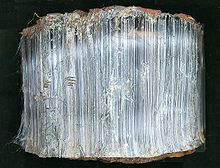Riebeckite
This article needs additional citations for verification. (January 2024) |
| Riebeckite | |
|---|---|
 Black riebeckite in an alkaline pegmatite from Lindinosa near Évisa, Corsica, France | |
| General | |
| Category | Silicate mineral |
| Formula (repeating unit) | Na2(Fe2+3Fe3+2)Si8O22(OH)2 |
| IMA symbol | Rbk[1] |
| Crystal system | Monoclinic |
| Crystal class | Prismatic (2/m) (same H-M symbol) |
| Space group | C2/m |
| Unit cell | a = 9.76 Å, b = 18.04 Å c = 5.33 Å; β = 103.59°; Z = 2 |
| Identification | |
| Color | Black, dark blue; dark blue to yellow-green in thin section |
| Crystal habit | As prismatic crystals, commonly fibrous, asbestiform; earthy, massive |
| Twinning | Simple or multiple twinning parallel to {100} |
| Cleavage | Perfect on {110}, intersecting at 56° and 124°; partings on {100} and {010} |
| Fracture | Conchoidal to uneven |
| Tenacity | Brittle |
| Mohs scale hardness | 6 |
| Luster | Vitreous to silky |
| Streak | Pale to bluish gray |
| Diaphaneity | Semitransparent |
| Specific gravity | 3.28–3.44 |
| Optical properties | Biaxial (−) |
| Refractive index | nα = 1.680–1.698 nβ = 1.683–1.700 nγ = 1.685–1.706 |
| Birefringence | δ = 0.005–0.008 |
| Pleochroism | X = blue, indigo; Y = yellowish green, yellow brown; Z = dark blue |
| 2V angle | Measured: 68° to 85°, Calculated: 62° to 78° |
| Dispersion | Strong |
| References | [2][3][4][5] |
Riebeckite is a sodium-rich member of the amphibole group of silicate minerals, chemical formula Na2(Fe2+3Fe3+2)Si8O22(OH)2. It forms a solid solution series with magnesioriebeckite. It crystallizes in the monoclinic system, usually as long prismatic crystals showing a diamond-shaped cross section, but also in fibrous, bladed, acicular, columnar, and radiating forms. Its Mohs hardness is 5.0–6.0, and its specific gravity is 3.0–3.4. Cleavage is perfect, two directions in the shape of a diamond; fracture is uneven, splintery. It is often translucent to nearly opaque.
Name and discovery
[edit]Riebeckite was first described in 1888 for an occurrence on Socotra Island, Aden Governorate, Yemen, and named for German explorer Emil Riebeck (1853–1885).[3]
The mineral is also known as crocidolite.[6]: 50
Occurrence
[edit]Riebeckite typically forms dark-blue elongated to fibrous crystals in highly alkali granites, syenites, rarely in felsic volcanics, granite pegmatites and schist. It occurs in banded iron formations as the asbestiform variety crocidolite (blue asbestos). It occurs in association with aegirine, nepheline, albite, arfvedsonite in igneous rocks; with tremolite, ferro-actinolite in metamorphic rocks; and with grunerite, magnetite, hematite, stilpnomelane, ankerite, siderite, calcite, chalcedonic quartz in iron formations.[2]
Riebeckite granite
[edit]The riebeckite granite known as ailsite, found on the island of Ailsa Craig in western Scotland, is prized for its use in the manufacture of curling stones.
Riebeckite granite was used for the facing stones of the Canton Viaduct from Moyles Quarry (a.k.a. Canton Viaduct Quarry) now part of Borderland State Park in Massachusetts, US. The commonwealth's name is even taken from an Algonquian word for the Great Blue Hill, which got its color from this form of granite.
Crocidolite (fibrous riebeckite)
[edit]
The fibrous forms of riebeckite are known as crocidolite and are one of the six recognised types of asbestos. Often referred to as blue asbestos, it is considered the most hazardous. The association between blue asbestos and mesothelioma was established by J. C. Wagner, C. A. Sleggs, and P. Marchand by 1960.[7]
Crocidolite asbestos was mined in South Africa, Bolivia, and Wittenoom, Western Australia. Bolivian crocidolite was used in approximately 13 billion Kent Micronite cigarette filters, manufactured from March 1952 until at least May 1956 by the Lorillard Tobacco Company (now part of the R. J. Reynolds Tobacco Company). Blue asbestos was also used to similar effect, and hazard, in early gas masks.
See also
[edit]- List of minerals – List of minerals with Wikipedia articles
- List of minerals named after people
References
[edit]- ^ Warr, L.N. (2021). "IMA–CNMNC approved mineral symbols". Mineralogical Magazine. 85 (3): 291–320. Bibcode:2021MinM...85..291W. doi:10.1180/mgm.2021.43. S2CID 235729616.
- ^ a b "Riebeckite", Handbook of Mineralogy, Mineral Data Publishing, 2001
- ^ a b "Riebeckite", Mindat.org
- ^ "Riebeckite", The Mineralogy Database (webmineral.com)
- ^ "IMA Master List". Archived from the original on 2015-01-05. Retrieved 2014-05-12.
- ^ Medicine, Institute of; Practices, Board on Population Health and Public Health; Effects, Committee on Asbestos: Selected Health (2006-09-23). Asbestos: Selected Cancers. National Academies Press. ISBN 978-0-309-10169-1.
- ^ Wagner, J. C. (1 June 1991). "The discovery of the association between blue asbestos and mesotheliomas and the aftermath". Occupational and Environmental Medicine. 48 (6): 399–403. doi:10.1136/oem.48.6.399. PMC 1035386. PMID 2064978.
External links
[edit]- Chisholm, Hugh, ed. (1911). . Encyclopædia Britannica. Vol. 7 (11th ed.). Cambridge University Press. p. 477.
